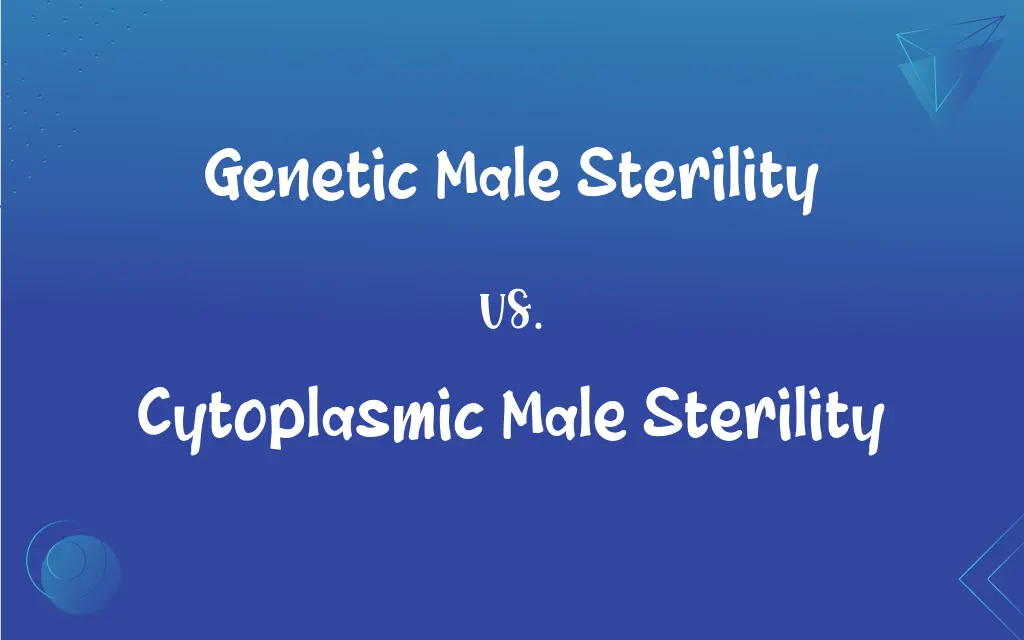Genetic Male Sterility vs. Cytoplasmic Male Sterility: What's the Difference?
Edited by Aimie Carlson || By Janet White || Published on February 19, 2024
Genetic male sterility is caused by nuclear genes, whereas cytoplasmic male sterility results from interactions between nuclear and cytoplasmic genes.

Key Differences
Genetic male sterility is a heritable trait caused by specific nuclear genes, resulting in the inability to produce or release functional pollen. Conversely, cytoplasmic male sterility (CMS) arises from a combination of nuclear and mitochondrial gene interactions, leading to pollen development failure.
In genetic male sterility, the sterility trait is inherited according to Mendelian genetics, often showing simple recessive inheritance patterns. In contrast, CMS is inherited maternally as it involves mitochondrial DNA, distinct from the typical Mendelian inheritance.
Genetic male sterility can be reversed or manipulated using traditional breeding techniques by altering the responsible nuclear genes. CMS, however, often requires the introduction of specific nuclear restorer genes to reverse the sterility.
The application of genetic male sterility is predominantly in plant breeding for hybrid seed production. CMS is similarly used in hybrid seed production but is particularly valued for its stable and consistent expression of sterility.
Genetic male sterility can be more easily controlled in breeding programs due to its predictable inheritance. In contrast, CMS, with its complex genetic and cytoplasmic interactions, may require more careful management in breeding programs.
ADVERTISEMENT
Comparison Chart
Cause of Sterility
Specific nuclear genes
Interactions between nuclear and mitochondrial genes
Inheritance Pattern
Mendelian genetics, often recessive
Maternally inherited, involving mitochondrial DNA
Reversibility and Manipulation
Possible through traditional breeding techniques
Requires specific nuclear restorer genes
Primary Application
Hybrid seed production, plant breeding
Hybrid seed production, stable sterility expression
Control in Breeding Programs
Easier due to predictable inheritance
More complex due to genetic and cytoplasmic interactions
ADVERTISEMENT
Genetic Male Sterility and Cytoplasmic Male Sterility Definitions
Genetic Male Sterility
Sterility in males caused by specific nuclear gene mutations.
Genetic male sterility in these plants was used to facilitate hybridization.
Cytoplasmic Male Sterility
A maternally inherited trait affecting pollen development.
The plant inherited cytoplasmic male sterility from its maternal lineage.
Genetic Male Sterility
A condition preventing functional pollen production due to nuclear genes.
Breeding programs often utilize genetic male sterility to control pollination.
Cytoplasmic Male Sterility
Utilized in agriculture for stable expression of male sterility.
Cytoplasmic male sterility is key to the success of this hybrid breeding program.
Genetic Male Sterility
Heritable male sterility through nuclear genome alteration.
This crop variety's genetic male sterility is a result of targeted breeding.
Cytoplasmic Male Sterility
A complex trait involving both nuclear and cytoplasmic genetic factors.
Their research focuses on the intricate mechanisms of cytoplasmic male sterility.
Genetic Male Sterility
A genetic trait manipulated for plant breeding advantages.
They introduced a genetic male sterility gene to enhance hybrid seed production.
Cytoplasmic Male Sterility
Sterility resulting from interactions between nuclear and mitochondrial genes.
Cytoplasmic male sterility in these flowers prevents them from producing pollen.
Genetic Male Sterility
Inherited sterility following Mendelian genetics.
The plant's genetic male sterility is due to a recessive gene.
Cytoplasmic Male Sterility
A condition where mitochondrial gene mutations disrupt pollen production.
The mutation causing cytoplasmic male sterility was traced to mitochondrial DNA.
FAQs
How is cytoplasmic male sterility inherited?
It's inherited maternally through mitochondrial DNA.
What role does CMS play in plant breeding?
CMS is used for stable and consistent expression of male sterility in hybrid seed production.
How is genetic male sterility inherited?
It follows Mendelian inheritance patterns, often being recessive.
Can genetic male sterility be reversed?
Yes, through traditional breeding and genetic modification.
How do breeders use genetic male sterility?
It's used to control pollination and facilitate hybrid seed production.
Is genetic male sterility common in plants?
Yes, it's a relatively common trait used in agricultural breeding.
What's the significance of CMS in agriculture?
It's significant for producing hybrids without the need for manual emasculation.
Can CMS be transferred between plant species?
It can be through specific breeding techniques and genetic engineering.
What causes genetic male sterility?
It's caused by mutations in specific nuclear genes.
How is CMS identified in plants?
Through specific genetic and phenotypic markers.
Are there environmental factors affecting genetic male sterility?
Yes, environmental factors like temperature can influence its expression.
Can genetic male sterility be detected early in plant development?
Yes, through genetic screening and observing pollen development.
Can CMS be found in all plant species?
No, its occurrence varies among different plant species.
Can genetic male sterility affect crop yield?
Not directly, but it's used to enhance hybrid vigor, which can increase yield.
What's the impact of CMS on biodiversity?
It can affect biodiversity by limiting natural cross-pollination in certain crops.
Does CMS affect other plant parts besides pollen?
No, it specifically affects pollen development and fertility.
What's the difference in breeding techniques for both sterilities?
Genetic male sterility relies on traditional breeding, while CMS often requires genetic engineering.
How do mutations in nuclear genes cause genetic male sterility?
They disrupt the normal development and function of pollen.
Are there any disadvantages of using CMS?
It may complicate breeding programs due to its complex inheritance patterns.
Is CMS a permanent condition in plants?
Yes, unless reversed by specific nuclear restorer genes.
About Author
Written by
Janet WhiteJanet White has been an esteemed writer and blogger for Difference Wiki. Holding a Master's degree in Science and Medical Journalism from the prestigious Boston University, she has consistently demonstrated her expertise and passion for her field. When she's not immersed in her work, Janet relishes her time exercising, delving into a good book, and cherishing moments with friends and family.
Edited by
Aimie CarlsonAimie Carlson, holding a master's degree in English literature, is a fervent English language enthusiast. She lends her writing talents to Difference Wiki, a prominent website that specializes in comparisons, offering readers insightful analyses that both captivate and inform.































































